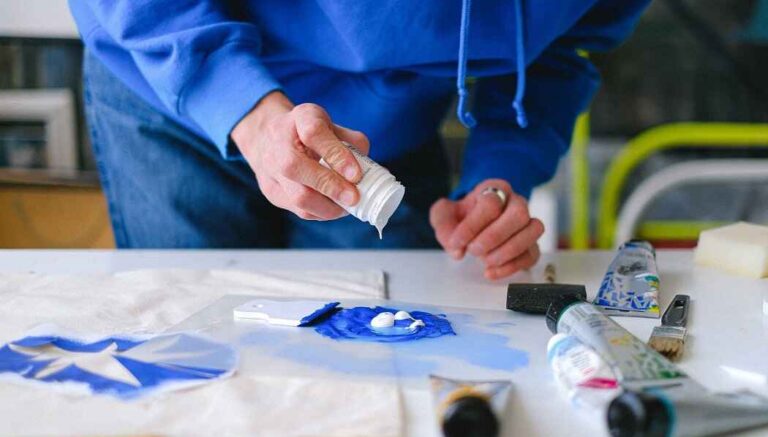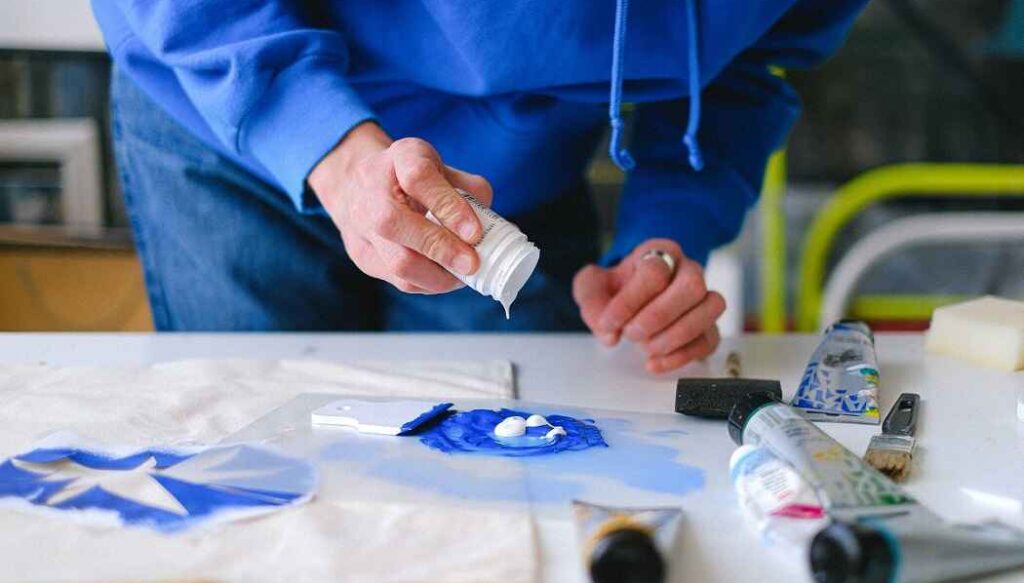
Can You Mix Water with Acrylic Paint for Pouring?
Yes, you can mix water with acrylic paint for pouring. Gradually add water to achieve desired consistency, ensuring smooth flow and proper adhesion. Experiment to find the right balance for your project.

So, whether you’re a budding artist or just someone who loves to get their hands dirty with paint, let’s embark on this creative adventure together!
Can You Mix Water with Acrylic Paint for Pouring?
Yes, mixing water with acrylic paint for pouring is a common technique used to achieve captivating fluid art effects. When done properly, it can create mesmerizing patterns and stunning color combinations. However, it’s important to approach this technique with care and understanding.
Water can be added to acrylic paint to thin its consistency, making it more suitable for pouring and allowing it to flow smoothly across the canvas. The addition of water can help create the desired viscosity, allowing the paint to easily mix and interact, resulting in beautiful marbling and cell formation.
It’s recommended to use a pouring medium along with water, as pouring mediums are specifically designed to maintain the paint’s color vibrancy, adhesion, and durability.
The mixture of water, acrylic paint, and pouring medium should be well-balanced, ensuring that the paint retains its integrity while still achieving the desired fluidity. Overly diluting the paint with water can result in a loss of color intensity and adhesion, leading to a less desirable outcome.
Experiment with different ratios of water, pouring medium, and acrylic paint to find the right balance that suits your creative vision and desired effects.
How Much Water Do You Put in Acrylic Paint to Pour?
There is no one-size-fits-all answer when it comes to acrylic pouring. The right ratios can vary based on factors such as the brand of paint, the desired consistency, the pouring technique being used, and personal preferences.
For a starting point, you can use a ratio of 1 part water to 5 parts acrylic paint. This means for every 1 unit (it could be grams, ounces, etc.) of paint, you would add 0.2 units of water. Here’s how it breaks down:
- 1 part acrylic paint
- 0.2 parts water
For example, if you have 100 grams of acrylic paint, you would add 20 grams of water (100 * 0.2 = 20). This easy calculation allows you to adjust the amounts according to the volume of paint you have.
Adding too much water can result in paint that becomes too transparent, loses vibrancy, and might not adhere well to the canvas. It’s recommended to gradually add water in small increments, mix thoroughly, and test the consistency before adding more.
Ultimately, the right amount of water to add to acrylic paint for pouring is a matter of experimentation. It’s a good idea to create small test batches using different ratios of water and paint to see how they interact and flow. This way, you can achieve the desired fluidity while retaining the color intensity and adhesion that acrylic paint is known for.
How Do You Thin Acrylic Paint for Pouring with Water?
Thinning acrylic paint for pouring with water involves a specific process to achieve the right consistency for fluid art. Here’s a step-by-step guide to help you achieve the best results:
Materials You’ll Need:
- Acrylic paint
- Pouring medium
- Water
- Mixing containers
- Stirring sticks or palette knives
- Protective surface or drop cloth
- Canvas or surface for pouring
- Plastic cups or squeeze bottles
- Gloves (optional)
- Torch or heat gun (optional, for removing air bubbles)
Step-by-Step Guide:
Prepare Your Workspace: Set up your workspace on a protected surface, as acrylic pouring can get messy. Place your canvas or surface on a raised platform or rack to catch excess paint and allow it to drip off.
Mixing Containers: Use separate mixing containers for each color you plan to use. Disposable plastic cups work well. The size of the container will depend on the amount of paint you need.
Acrylic Paint: Squeeze your desired acrylic paint colors into the mixing containers. Start with a small amount, as you can always add more paint if needed.
Pouring Medium: Add pouring medium to each container. The pouring medium helps to increase the flow of the paint and prevents cracking when the paint dries. The ratio of pouring medium to paint varies.
Water: Gradually add water to the paint and pouring medium mixture. Start with a small amount of water, as you can always add more if needed. The water helps to further thin the mixture and achieve the desired consistency for pouring.
Mix Thoroughly: Use a stirring stick or palette knife to mix the paint, pouring medium, and water thoroughly. Stir until you achieve a smooth, even consistency. Lift the stirring tool to check the paint’s consistency as it drips off – it should flow smoothly and not be too thick.
Consistency Test: Perform a consistency test by lifting the stirring stick or palette knife out of the mixture. The paint should flow off the tool in a continuous stream and quickly meld back into the mixture.
Adjust as Needed: If the mixture is too thick, add a little more water and mix again. If it’s too thin, you can add a touch more paint and/or pouring medium. Finding the right consistency may require some experimentation.
Repeat for Each Color: Repeat the mixing process for each color you plan to use in your pour.
Pouring: Once you have the desired consistency for each color, you can start pouring. There are various pouring techniques you can use, such as the “dirty pour,” “flip cup,” or “swipe.” Experiment to create your desired effects.
Tilt and Spread: Tilt your canvas in different directions to spread the paint and create interesting patterns. You can use palette knives or other tools to guide the paint as it flows across the surface.
Finishing Touches: Once you’re satisfied with the paint coverage, use a torch or heat gun (carefully) to remove any air bubbles that may have formed during the pouring process.
Drying: Allow your poured piece to dry completely. The drying time can vary based on factors like humidity and the thickness of the paint layers.
Remember that acrylic pouring is an art form that involves experimentation and creativity. Don’t be afraid to try different ratios and techniques to achieve the results you desire.
Final Words
While water can be used to thin acrylic paint and create different pouring effects, it’s essential to strike the right balance. Adding too much water can dilute the paint’s color intensity and binding properties, potentially affecting the final result.
It’s recommended to conduct experiments and find the right water-to-paint ratio that aligns with your artistic vision. Additionally, using specialized pouring mediums designed for acrylics can offer more consistent and predictable outcomes compared to relying solely on water.
